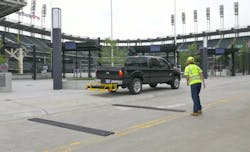WSDOT deploys temporary rumble strips in maintenance work zone
When the Washington State Department of Transportation (WSDOT) Eastern Region, located in Spokane, scheduled a two-day paving project this past August on S.R. 26 near Colfax, they decided to deploy RoadQuake Temporary Portable Rumble Strips (TPRS) in the work zone.
Colfax, Wash., 60 miles due south of Spokane, is about 16 miles northwest of Washington State University, in Pullman. As such, Colfax experiences a high volume of traffic of college students traveling to and from the campus. The stretch of S.R. 26 coming into Colfax is surrounded by wheat fields. Though some drivers consider that road quite beautiful, others find it boring, and seemingly endless. Those other drivers, especially those of college age, might pick up their phones to relieve any boredom. The combination of high speeds and low attention spans caused some concern.
That concern is warranted. Distracted driving in work zones might be even more dangerous than previously thought. The Washington Post recently reported that: “The study by researchers at the Risk Institute at Ohio State University found that distracted driving raises the odds that a crash will cause severe injury or death, compared with other crashes, particularly if those distraction-related crashes involve rear-end collisions or occur in work zones or on interstate highways.”
The Ohio State University (OSU) researchers had analyzed 1.4 million police crash reports. They discovered that distracted driving crashes had increased in Ohio between 2013-2017. The OSU researchers also discovered that “younger drivers—particularly those between 20 and 24 years of age—account for the highest percentage of crashes, both as a result of distracted driving and other causes.”
In addition to concerns about college-age, distracted drivers, WSDOT faced other safety issues:
- S.R. 26 features a posted speed limit of 60 mph; the speed limit would remain at 60 mph in the work zone;
- Plans called for a lane closure on the two-lane highway. Flaggers, always a very dangerous occupation, would be stationed at either end of the work zone. Pilot cars would guide traffic through the work zone; and
- Because of the lane closure, traffic queues would build up; distracted drivers could cause rear-end crashes.
Mark Bergman, WSDOT Eastern Region safety & health manager, decided to test RoadQuake TPRS in this work-zone application.
Designed to reduce crashes and save lives, RoadQuake TPRS alert drivers to changing road conditions, like upcoming lane closures and other work-zone applications. Manufactured by PSS in Cleveland, Ohio, RoadQuake TPRS is a temporary, transverse rumble strip, installed perpendicular to the direction of travel. Drivers feel the vibrations and hear the familiar “bumpety-bump, thumpety-thump” sounds of tires traveling over the rumble strips.
The crew set up warning signs for a lane closure with flagging operation: “Road Work Ahead,” “Be Prepared to Stop,” “One Lane Road Ahead” and “Flagger Symbol” signs were deployed in both directions of travel. In addition to those work-zone warning signs, WSDOT added a “Rumble Strips Ahead” sign and a “Motorcycles Use Extreme Caution” sign.
Bergman borrowed six RoadQuake TPRS, enough for two, three-strip arrays, from another WSDOT region. From a flatbed truck, the crew deployed a three-strip array ahead of the work zone in both directions of travel. They deployed each array in a matter of minutes, placing them about 500 ft before the flagger positions.
The deployment of RoadQuake TPRS raised a few questions and concerns. For example, at ¾-in. high, will the rumble strips cause motorcyclists to lose control of their vehicles? WSDOT discovered the answer soon after deployment. Motorcyclists driving through the work zone easily traversed the strips; cyclists showed no signs of losing control. Motorcyclists gave flaggers the “thumbs up” sign, and the work zone crew spoke to some of the motorcyclists while they waited in queue for the pilot car. Those motorcyclists commented positively about the rumble strips. They had no control issues while driving over them.
WSDOT also was concerned about movement of the strips in traffic. The topography helped answer this question. As the ground beyond the road’s shoulder sloped downward, Bergman walked down the slope until the road surface was at eye level. From that vantage point, Bergman watched as motorcycles, small cars and trucks, and 18-wheel tractor-trailers drove over the rumble strip arrays. The strips showed no movement.
WSDOT was of course most concerned about the effectiveness of RoadQuake. Would they alert drivers to the upcoming work zone and the flaggers? The agency again discovered the answer soon after deployment. They watched as drivers looked up and around when they approached or drove over the strips. Drivers were now focused on the road before them. WSDOT saw upward of 90% of the drivers apply their brakes. Several drivers put their phones down. Most importantly, drivers did not “come in hot” to the flagger stations. Drivers, very focused, approached flaggers cautiously.
WSDOT reported that no crashes occurred in the work zone.
